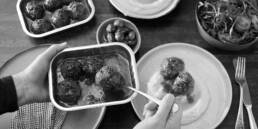Plywood exhibits its flexibility, beauty and economy
This Content Marketing article was produced for Ecoply and first appeared in Architectural Product News magazine.
From humble beginnings on a sheet of plywood with a set of legs to a successful architecture practice celebrating fellow architects in a provocative exhibition at the Tin Sheds Gallery at the University of Sydney. Exhibition curators Anita Panov and Andrew Scott of Panovscott took their long love affair with plywood and turned it into an art-piece.

Each project in the exhibition is small in scale yet big on ideas and was selected, “to actively engage in a discourse of how we can live more efficiently,” said Scott. Aptly titled ‘A small exhibition,’ it celebrated projects that economically and environmentally have improved the lives of their inhabitants within very small spaces.
“For us, these projects clearly demonstrate innovation in how we can live more efficiently with higher amenity … how we can enjoy life more with less, which in turn is a more responsible attitude to those around us and to future generations,” wrote curators Panov and Scott in the exhibition’s catalogue.
Inside the gallery two structures were constructed using Ecoply plywood and finished in a striking, blue-wash. One was a 1:1 scale replica of a 27-square-metre studio apartment designed by Nicholas Gurney that boldly demonstrated how little space one can comfortably live in, with good design. The outer walls of this structure also doubled as additional hanging space for drawings and photographs. The second, presented an enticing face to the street through a large picture window – a forced perspective viewing apparatus that held project models, suspended in space.
“We wanted to introduce a number of experiences and see how people could inhabit the exhibition,” explained Scott. Plywood was selected for its flexibility, familiarity for Panov and Scott who express love for the material and for its cost effectiveness. In future months, Panov expects to see sky blue models in the architecture department as the exhibition materials are re-used by the students.
In their architectural work, Panovscott endeavour to be sensitive to the environment and as efficient as possible in design and construction, “to use structure as finish” where appropriate. So materials like Ecoply plywood provide that option as it’s structural and can be left raw or finished in numerous ways.
Ecoply is also manufactured from sustainably grown Australian and New Zealand plantation pine. Environmental Life Cycle Analysis (LCA) is recognised as the preferred cradle-to-grave basis for comparing the environmental impact of products, including building materials. On a limited LCA basis, building in wood sourced from sustainably-managed plantations represents a net removal of carbon dioxide away from the atmosphere for at least the life of the structure.
As such, building in wood sourced from sustainably-managed plantations can therefore make a positive contribution to combating climate change. Which is good news for the next generation.
Interestingly, that plywood table is still the heart of the Panovscott practice. It’s the centerpiece of inspiration. With regards to what drives the practice, Panov explained, “Good design enables a better way of living.” And at the end of the day, that’s all anyone could want.




